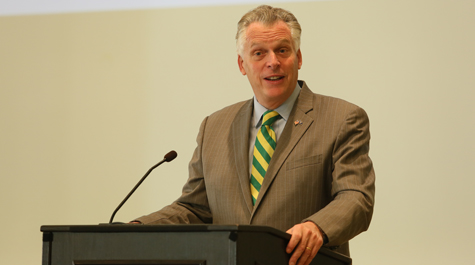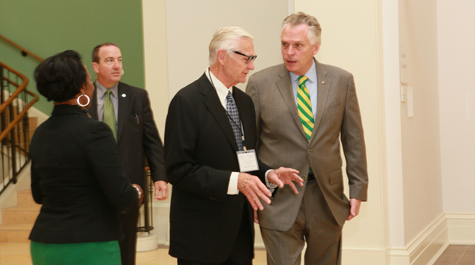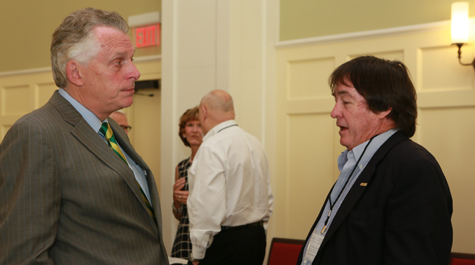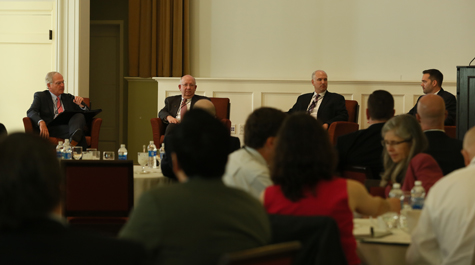McAuliffe: Data analytics is essential for a prosperous Commonwealth
The integration of data analytics into the humanities will be integral to the future success of Virginia’s workforce, Virginia Gov. Terry McAuliffe said at William & Mary Tuesday.
“I think those in the humanities sector have the greatest opportunity to become data scientists,” he said. “… You have a responsibility, I believe, to your students to make sure you are getting them all in what I call the data analytics game. It is absolutely crucial to the future of these students.”
McAuliffe spoke to representatives from 14 institutions of higher education in Virginia who gathered at W&M’s School of Education and Raymond A. Mason School of Business Oct. 17 and 18 for the Commonwealth Data Analytics and Humanities Summit. A joint effort organized by the Business Higher Education Forum and governor’s office, the summit provided attendees an opportunity to learn about the application of data science in the liberal arts, discuss what colleges and universities in Virginia are doing to implement that and identify opportunities for collaboration.
{{youtube:medium:left|GkOF7IVNwOk, McAuliffe discusses data and the humanities}}
In addition to McAuliffe, Virginia Secretary of Education Dietra Trent, Virginia Secretary of Technology Karen Jackson, W&M President Taylor Reveley and W&M Provost Michael R. Halleran spoke at the event.
“In the final analysis, people are the primary study of the humanities,” said Reveley. “I think it’s increasingly important that students, whenever possible in colleges and universities, get a sense of the power of big data, the power of data analytics, to help engage in solving societal issues, to teach us in new and transformative ways and simply to add to the zest and the life of life. It’s an extraordinary area, just really beginning to take hold in a major way in most colleges and universities.”
A new economy
The last period of federal government sequestration, from 2011 to 2013, had a major impact on Virginia’s economy, and another — potentially worse — sequestration may take place next October, McAuliffe said.
With defense spending increasingly unreliable, the governor has been working to create a new economy in Virginia, one that is focused more on technology than federal funding. As such, he has been traveling around the world to bring new businesses — and, with those, new jobs — to the Commonwealth, he said. Currently, 37,000 jobs in the high-technology sector are open in the state, including 17,000 cyber jobs.
“Either we fill those jobs, folks, or those jobs go to other states,” he said. “That’s how serious this is, and that’s why all of this big data and analytics is really so important. We’ve got in the game in making sure we’re filling these high-tech jobs for the Commonwealth of Virginia. It is absolutely critical to our success, and it comes down to our education system.”
Integrating data analytics in the humanities is vital to the achievement of that vision, McAuliffe said, as that will produce people with a “three-dimensional way of looking at a problem.”
“It’s understanding the issue, understanding the problem, using that data, coming up with a logical reasoning thought process to come up with a solution and then communicating that,” he said.
McAuliffe noted one such application of data science by announcing the launch of the Bay Data section of the Commonwealth’s Open Data Portal. Presented by W&M’s Virginia Institute of Marine Science, the initiative provides a wide variety of open data sets related to the bay, from indices of fish and crab abundance to inventories of tidal-marsh condition and health, according to a press release from the governor’s office.
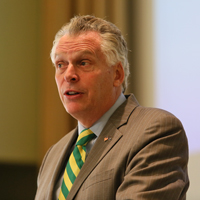 “We are making decades of research and hard work available to the public so scientists, entrepreneurs, and innovators can build on this information and develop the next generation of tools to help us maintain and preserve this valuable ecosystem,” McAuliffe said in the release.
“We are making decades of research and hard work available to the public so scientists, entrepreneurs, and innovators can build on this information and develop the next generation of tools to help us maintain and preserve this valuable ecosystem,” McAuliffe said in the release.
Everyone has to be involved in data analytics going forward, he said, encouraging the summit’s attendees to be bold in their related initiatives.
“You’ve got all the tools folks, it’s time to fire up,” he said. “… The future, our students are counting on you.”
Data science at W&M
In a panel session on Monday, three William & Mary professors — Daniel Miller Runfola, Mark Luckenbach and Michael Tierney — explored an extensive list of data science projects being undertaken at the university.
Runfola, AidData's geospatial scientist, discussed a project that maps impoverished populations throughout the world using a combination of nighttime lights and Google Maps imagery.
"This was the product of an economist and a computer scientist walking into a bar,” he said. “Going back to the 90s we’ve had night-time lights imagery. An economist had the great idea ‘Oh, when you look at Google Earth you can tell how impoverished people are based on what their roofs look like.’ You combine those resources of data using convolution neural networks — deep learning — and you get some amazing things out of it."
Luckenbach, associate dean of Research and Advisory Services at VIMS, discussed the Coastal Bay Shark Survey, which began in 1973 and is the largest ongoing shark survey in the world.
“There’s 10 common shark species here and another 20 that do come into the Bay in this area,” he said. “We do really extensive tagging studies. We stick acoustic tags in them and we stick satellite tags in some of them, so we can get data back from satellites, a lot of data. The data, however, is all open-access. You can go to a website, click on it and read all about sharks ... All of this data is used annually by state and federal fisheries management agencies.”
Tierney, a professor of government and international relations who is director of the Institute for the Theory and Practice of International Relations (ITPIR), pointed to work headed by Professor Steve Schellman, research associate for the International Security Project, which studies terrorism and political violence.
“What he’s interested in doing is predicting, forecasting, terrorist attacks, coups, civil wars and other types of violence conflict — typically outside of the US,” Tierney said.
“There’s all of this raw information that comes through media sources, Twitter, different social media. Steve and his students suck off lots of this unstructured data in this unstructured format. They use a system of content analysis to figure out who the actors are in these bits of text and what they’re doing — but also what their sentiment is ... Once you program that in, he’s got this underlying political psychology model — actually dozens of these models — that look at the same data and then they do a fancy version of averaging them in order to try to forecast.”
Data science in the humanities
Trent opened up the summit sessions Tuesday morning with a call for inter-institutional collaboration among Virginia’s colleges and universities to advance data analytics in general and to encourage the use of technology in the humanities.
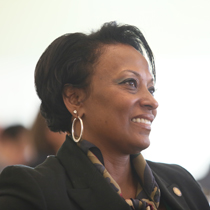 “Each of you is uniquely positioned to help shape this field because of your strengths across the traditional disciplines,” she told the faculty and administrators of more than a dozen Virginia colleges and universities gathered in the Brinkley Commons Room of Allan B. Miller Hall, home of William & Mary’s Mason School of Business.
“Each of you is uniquely positioned to help shape this field because of your strengths across the traditional disciplines,” she told the faculty and administrators of more than a dozen Virginia colleges and universities gathered in the Brinkley Commons Room of Allan B. Miller Hall, home of William & Mary’s Mason School of Business.
“The Commonwealth needs you engaged in data analytics and we need you to train the next generation,” Trent said. “That is why it is so important to have you all here today — to engage with each other, to gain new insights and then to take it back to your institutions to share there.”
A late-morning panel session, moderated by Ashley Bear from the National Academies of Science, Engineering and Medicine explored current examples of data science in the humanities. Joel Schwartz, director of William & Mary’s Charles Center, was a participant, as was Eva Caldera from the National Endowment for the Humanities and E. Thomas Ewing, a history professor from Virginia Tech.
The panelists gave successful and promising examples of humanities projects that benefitted from data-science applications and some administrative efforts that have proven useful. Schwartz, for example, pointed to William & Mary’s Center for Geospatial Analysis (CGA.
“If you look around the country, GIS centers tend to be within geology departments, within environmental science or environmental engineering programs,” Schwartz said. “There may be three of them on campus, each owned by a separate silo within the institution.
“That is not the recipe for successful use of GIS throughout the curriculum,” he pointed out. “At William & Mary, we’re fortunate that we’ve created a center for geospatial analysis that sits outside the department and college structure and is equally available to everyone.”
Institution-wide access to the CGA has paid off, he said. Schwartz gave as examples the data-enhanced projects among last year’s senior honor theses at William & Mary.
“There were 18 theses that used GIS as core methodology,” he said. “Five of them were in the humanities. In fact, the young woman who was studying the geographical spread of folklore motifs in Italy was the most tooled-up GIS scientist.”
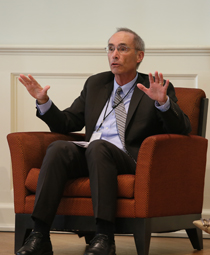 Caldera noted that the NEH has been engaged in the digital humanities for 10 years and said that many the “early voices” within the grant-distributing agency of the U.S. government were well aware of the potential connection between technology and culture. She said the NEH is interested in not just what tech can do for the humanities, but also the opposite.
Caldera noted that the NEH has been engaged in the digital humanities for 10 years and said that many the “early voices” within the grant-distributing agency of the U.S. government were well aware of the potential connection between technology and culture. She said the NEH is interested in not just what tech can do for the humanities, but also the opposite.
“How does the humanities help us to ask the big questions about technology in our lives?” she asked.
Ewing drew on his experience to offer some observations on the intersection of data science and the humanities. He pointed out that the humanities emphasize interpretation across scale.
“For the humanities scholar, the individual matters tremendously, but we also look at larger aggregations of people, at nations, at movements, and so on,” he said, explaining that data analytics can reach across scale, too, from the individual level to the world.
“And humanities does the same thing,” he added, “so the more we recognize those connections, the more we can use humanities to inform data analytics and vice versa.”
Ewing noted that the humanities address complex problems, trying to understand the behavior, attitudes and ideologies behind them, often using primary sources such as novels or other texts and works of art.
“This is something that I think the humanities can offer a lot that may be missing from data analytics, ” he said. “Data is ultimately reductionist. It is about taking complicated questions, and reducing it so that it can be categorized and measured.”
The group discussed challenges to the incorporation of data-savvy techniques into the humanities, particularly at the undergraduate level. One persistent set of questions deals with the level of data-tech knowhow that is proper for each scholar.
Isabel Cadenas-Navia, director of the Business Education Forum, presented results from a survey about adoption and attitudes toward integration and adoption of data science and data analytics in the curricula of a number of institutions. Former William & Mary administrator Jodi Fisler returned in her new position as SCHEV associate for assessment policy and analysis to moderate a discussion among the attendees.
The discussion led to a consensus that regular meetings of the group would be helpful, as would an online depository of relevant materials. Jackson volunteered to have her office coordinate some sort of digital clearinghouse for sharing of materials as well as
First step
Jackson closed out the summit, thanking the attendees and indicating that she would support the initiative to integrate data analytics into the humanities.
“This is the first step in a journey,” she said. “You know how people hate to hear ‘I’m from the government and I’m here to help you.’ But in this case I’m just going to stay out of your way and let you all do what you do.”
She noted that 14 colleges and universities were represented at the summit and she asked the attendees to think about other institutions that should be involved. She also urged the academics to collaborate on the initiative.
“No one has to do this by themselves,” she said.
Joseph McClain, Jim Ducibella and Erin Zagursky contributed to this story.














